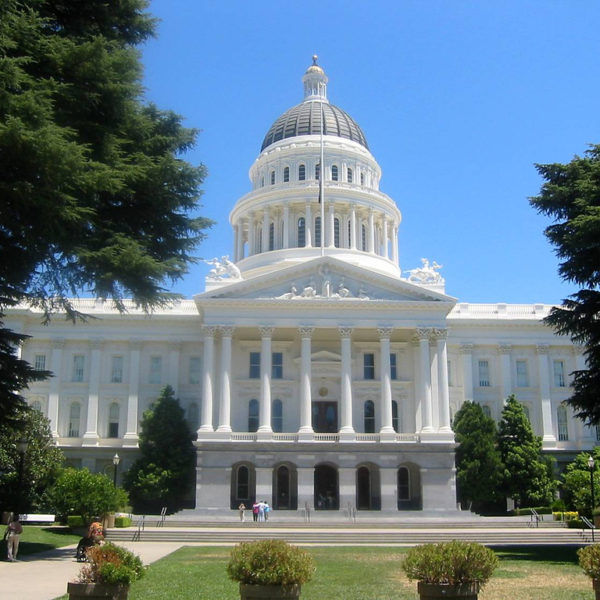Debunking the Plastic Industry’s Myths on California’s Plastic Pollution Reduction Bill
Last month, legislators voted to advance the California Circular Economy and Plastic Pollution Reduction Act, representing what would be the most comprehensive state-wide legislation in the US to reduce plastic pollution. It would phase out nonrecyclable single-use plastics, and redefine what’s truly recyclable. This is the basis we need for a circular system — with more recycled material going into new products, less demand for ‘fracked’ virgin plastic, and new green jobs in recycling and plastic-free business models.
Passing this bill would be a huge win for our movement… but we’re not there yet. With major votes happening in the next two months, the plastic industry is ramping up a misinformation campaign to derail the bill. Below we set straight the most prominent myths being pushed by the plastic industry to legislators and why they’re wrong.
MYTH: The scope of the bills are too broad and/or unclear about which products are included.
FACT: The bills establish a material-neutral, comprehensive framework to address the growing pollution crisis by focusing on single-use packaging and products which are, by far, the largest contributor. The authors have been working closely with stakeholders to clarify definitions and criteria for products to be covered under the bill. Additionally, the bill clearly states that CalRecycle will further refine the types of products during the scoping plan process which requires extensive stakeholder input.
MYTH: The bills give CalRecycle too much authority.
FACT: These bills give CalRecycle the appropriate amount of authority to guarantee that the goals of the bills are met with a degree of certainty and immediacy that the legislative process simply does not allow. Only CalRecycle has the technical expertise necessary to monitor and evaluate the complex and ever-changing conditions of the waste and recycling industry. All regulatory considerations would require opportunities for all stakeholders to participate.
This is how the Legislature deals with complicated issues. Numerous landmark California laws, including AB 32 and our clean air and water statutes, have begun with a framework that includes defined guidelines and criteria for departments to carry out legislative goals. As with any legislation, the Legislature maintains its oversight authority of departmental implementation through the budget and policy committee hearings and actions.
MYTH: These bills would impact California jobs.
FACT: By increasing and incentivizing in-state recycling and composting, and encouraging in-state manufacturing using recycled material, these bills will stimulate California’s economy and create jobs in these sectors. Per ton of material handled, recycling creates an average of ten times more jobs than trash, composting creates at least twice as many jobs as landfills, and reuse creates as many as 30 times more jobs as landfills.1 Additionally, the jobs that are currently making disposable products can and are easily transitioning to making reusable products and systems, recyclables, and compostables, and many such businesses support these bills.
Los Angeles is in the midst of transforming its waste and recycling system into a model that will result in maximum recycling and reuse of materials for economic benefit, with government and industry as strategic partners in managing resources, and with a sustainable workforce infrastructure for skilled laborers, entrepreneurs, and innovators. Recycling-related industries in Los Angeles County already have 53,000 full-time employees, 3,000 businesses, and nearly $2.5 billion in annual wages. By building a clean recycling economy, the Los Angeles area could grow 20,000+ regional jobs.2
MYTH: These bills will raise prices for consumers.
FACT: Taxpayers and local governments are already being burdened with clean-up costs. While the state and local communities in California have tried to reduce the burden from single-use packaging since the 1980s, taxpayers and local governments still spend over $420 million annually in ongoing efforts to clean up and prevent litter in streets, storm drains, parks and waterways.3
These bills relieve the pressure on local governments and ratepayers, who have endured rate increases since China and other countries stopped accepting our waste, by creating a market for the material and by giving manufacturers a stake in the end life of their products. Local jurisdictions that once profited from collecting and processing recyclable material now have to pay to dispose of it. In places like Folsom, that has meant a financial burden to their budget of nearly a million dollars. For Los Angeles, it’s much more.4
1 https://www.ecocyclesolutionshub.org/about-zero-waste/jobs-eco-impact/ 2 http://www.laane.org/wp-content/uploads/2014/05/RecyclingJobsinLA_Report2014.pdf
2 http://www.laane.org/wp-content/uploads/2014/05/RecyclingJobsinLA_Report2014.pdf
3 NRDC, “Waste in Our Water: The Annual Cost to CA Communities of Reducing Litter That Pollutes Our Waterways,” August 2013
4 League of California Cities; https://www.cacities.org
Ready to take action to get these bills passed? Add your name here to help us get these bills across the finish line!





